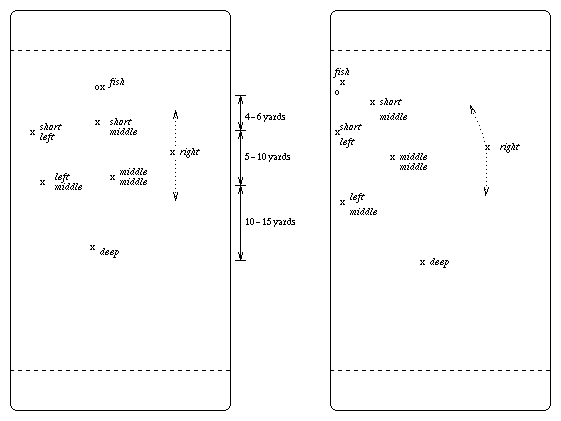Would you like to make this site your homepage? It's fast and easy...
Yes, Please make this my home page!
Fish Zone
This zone is particularly devastating when the trap is set up
as shown in the figure on the right. Thus, one of the goals of this
zone is to force the disc to the sideline without giving up to much
ground. If there's any kind of cross wind, then the fish should
force the disc towards the sideline that is in the downwind direction.
This makes getting the disc out of the trap situation even harder.

- Non-trap set (shown on the left)
- The fish is responsible for forcing the disc towards
one side of the field. The fish is the only player that
marks the disc. If they get really tired, they might
be able to change positions with either the short middle
or strong-side short after a trap.
- The short middle is the most important position. This
person has to be aware of all cuts through the center
and at the same time break up any give and go opportunities.
- The middle middle patrols the middle of the field, but more
importantly, is responsible for positioning and communcicating
with the short middle.
- The short on the forced-side of the field (short left
as shown in the figure) can back up
a bit to sucker the disc towards the sideline where
we want to trap. In the case where the disc gets to the
opposite sideline (the non-trapped one, or right side as
shown in the figure), this short doesn't
want to go past (further right than) the middle of the field.
- The middle on the forced-side (left middle as shown in
the figure) prevents any hammers and pretty much plays man
defense for people in his/her zone.
- The weak-side player (right as shown in the figure)
has a lot of flexibility and can either
play up or back depending on the situation and how the other
team has been beating us.
- The deep does the usual barking and minding of deep threats.
- Trap set (shown on the right)
- Once the disc gets on the sideline the fish (or
short middle) will move to deny the dump. The
short middle (or fish)
will move to cut off a swing. The short on the forced-side
of the field (short left as shown in the figure)
will move up to be 10 feet away from the disc to prevent an
easy pass down the
line. These three players are basically like a cup in
a standard zone.
- The middle middle protects against any throws
through the cup.
- The middle on the forced-side (left middle as shown
in the figure) backs up down the sideline, weary of any big
bending throws down the line.
- The weak-side player (right as shown in the figure)
has the most ground to cover. However, since these are
long throws, probably into the wind, this person has a bit
of time to get to an ambitious swing or cross field hammer.
Because of the mobility and field awareness that is required
for this position, people that can play deeps in normal zones
are ideal.
- The deep watches deep threats and may call back the
middle on the forced-side (left middle as shown in
the figure) for help.
Note: strong-side = side of the field to which we're forcing. In
the figure above, the strong-side is the left side.
weak-side = opposite-side of the field.
return to playbook index
